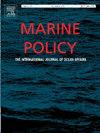Towards a strategy for offshore installations to enhance the environmental status of coastal seas: Multi-use concepts for ecosystem restoration
IF 3.7
2区 社会学
Q2 ENVIRONMENTAL STUDIES
引用次数: 0
Abstract
In European coastal and shelf seas, concurrent and sometimes conflicting economic and conservation needs call for innovative spatial management approaches that take account of new use concepts. In highly degraded environments, large areas contemplated for offshore wind farm (OWF) development could be actively used for different ecosystem enhancement concepts such as habitat restoration or the establishment of artificial reefs as part of conventional scour protection systems. Simultaneously, different uses, such as extractive aquaculture or other offshore renewable energy could be located within OWFs to more efficiently use limited marine space while also maximizing the benefit of a site. However, to date the environmental and spatial enhancement potential of such multi-use approaches is rarely considered in OWF planning and development. One concern is that stronger focus on such enhancement approaches could lead to reduced efforts in other urgent nature protection needs such as Marine Protected Areas (MPAs). We argue that co-designed by knowledgeable stakeholders, and effectively implemented, appropriate forms of multi-use concepts could help with impact reduction of OWF areas and the improvement of the already floundering ecosystem status of coastal and shelf seas, all while maintaining urgently needed conservation schemes.
提高沿海海域环境状况的近海设施战略:生态系统恢复的多用途概念
在欧洲沿海和大陆架海,经济和养护需要同时存在,有时相互冲突,因此需要考虑到新的使用概念的创新空间管理办法。在高度退化的环境中,考虑开发海上风电场(OWF)的大片区域可以积极用于不同的生态系统增强概念,如栖息地恢复或建立人工鱼礁作为常规冲刷保护系统的一部分。同时,不同的用途,如采掘水产养殖或其他海上可再生能源,可以在自由渔场内更有效地利用有限的海洋空间,同时也最大限度地发挥场地的效益。然而,迄今为止,这种多用途方法的环境和空间改善潜力很少被考虑在OWF的规划和发展中。一个令人担忧的问题是,对这种增强方法的更强烈关注可能会导致在海洋保护区等其他迫切自然保护需求方面的努力减少。我们认为,由知识渊博的利益相关者共同设计并有效实施,适当形式的多用途概念可以帮助减少OWF区域的影响,改善已经陷入困境的沿海和大陆架海生态系统状况,同时维持迫切需要的保护计划。
本文章由计算机程序翻译,如有差异,请以英文原文为准。
求助全文
约1分钟内获得全文
求助全文
来源期刊

Marine Policy
Multiple-
CiteScore
7.60
自引率
13.20%
发文量
428
期刊介绍:
Marine Policy is the leading journal of ocean policy studies. It offers researchers, analysts and policy makers a unique combination of analyses in the principal social science disciplines relevant to the formulation of marine policy. Major articles are contributed by specialists in marine affairs, including marine economists and marine resource managers, political scientists, marine scientists, international lawyers, geographers and anthropologists. Drawing on their expertise and research, the journal covers: international, regional and national marine policies; institutional arrangements for the management and regulation of marine activities, including fisheries and shipping; conflict resolution; marine pollution and environment; conservation and use of marine resources. Regular features of Marine Policy include research reports, conference reports and reports on current developments to keep readers up-to-date with the latest developments and research in ocean affairs.
 求助内容:
求助内容: 应助结果提醒方式:
应助结果提醒方式:


